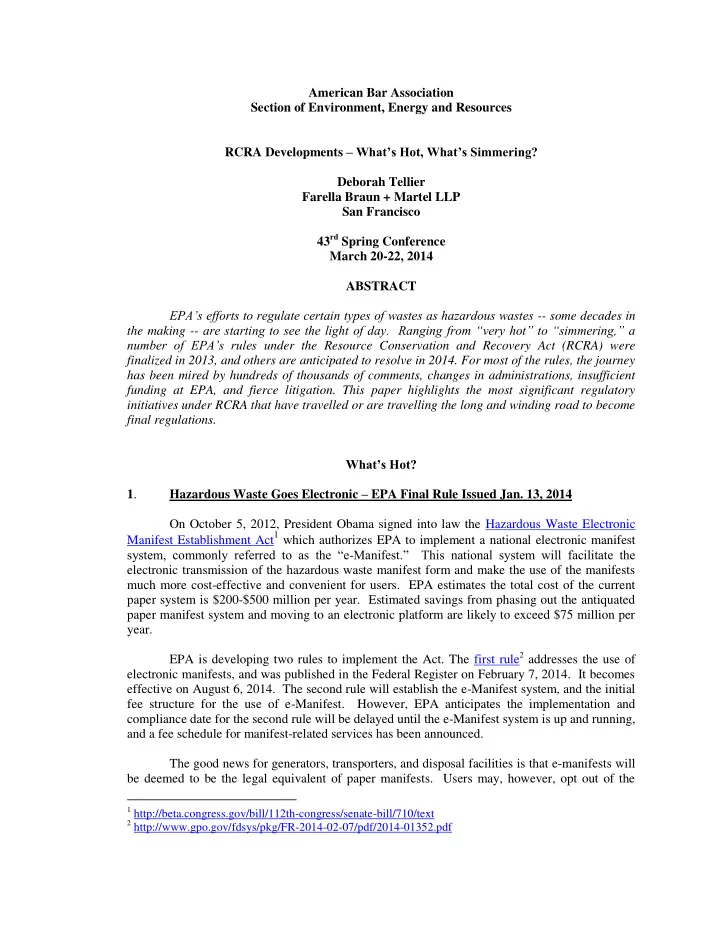

American Bar Association Section of Environment, Energy and Resources RCRA Developments – What’s Hot, What’s Simmering? Deborah Tellier Farella Braun + Martel LLP San Francisco 43 rd Spring Conference March 20-22, 2014 ABSTRACT EPA’s efforts to regulate certain types of wastes as hazardous wastes -- some decades in the making -- are starting to see the light of day. Ranging from “very hot” to “simmering,” a number of EPA’s rules u nder the Resource Conservation and Recovery Act (RCRA) were finalized in 2013, and others are anticipated to resolve in 2014. For most of the rules, the journey has been mired by hundreds of thousands of comments, changes in administrations, insufficient funding at EPA, and fierce litigation. This paper highlights the most significant regulatory initiatives under RCRA that have travelled or are travelling the long and winding road to become final regulations. What’s Hot? Hazardous Waste Goes Electronic – EPA Final Rule Issued Jan. 13, 2014 1 . On October 5, 2012, President Obama signed into law the Hazardous Waste Electronic Manifest Establishment Act 1 which authorizes EPA to implement a national electronic manifest system, commonly referred to as the “e - Manifest.” This national system will facilitate the electronic transmission of the hazardous waste manifest form and make the use of the manifests much more cost-effective and convenient for users. EPA estimates the total cost of the current paper system is $200-$500 million per year. Estimated savings from phasing out the antiquated paper manifest system and moving to an electronic platform are likely to exceed $75 million per year. EPA is developing two rules to implement the Act. The first rule 2 addresses the use of electronic manifests, and was published in the Federal Register on February 7, 2014. It becomes effective on August 6, 2014. The second rule will establish the e-Manifest system, and the initial fee structure for the use of e-Manifest. However, EPA anticipates the implementation and compliance date for the second rule will be delayed until the e-Manifest system is up and running, and a fee schedule for manifest-related services has been announced. The good news for generators, transporters, and disposal facilities is that e-manifests will be deemed to be the legal equivalent of paper manifests. Users may, however, opt out of the 1 http://beta.congress.gov/bill/112th-congress/senate-bill/710/text 2 http://www.gpo.gov/fdsys/pkg/FR-2014-02-07/pdf/2014-01352.pdf
electronic system, and continue to use hard copy manifests instead. In such cases, EPA will still accept paper manifests, but will process the data from those manifests so that they are included in the e-Manifest system. EPA will also be evaluating the fee structure for e-Manifests to ensure it can recover costs of processing both electronic and paper manifests. EPA is signaling its strong preference for generators, transporters, and disposal facilities to go electronic as soon as possible. EPA recognizes that many states regulate additional wastes as hazardous or special wastes under their state regulatory programs. Fortunately for hazardous waste generators, especially in California which regulates many types of non-RCRA hazardous wastes, the national e-Manifest system can also be used to track such state-regulated wastes. The final rule will still require authorization by the states. Electronic FAQs 3 are posted on EPA’s website. The regulated community has expressed concern that EPA will treat all data contained in individual hazardous waste manifests as public information, available to anyone online, and thus ineligible for treatment as confidential business information. This transparency may allow competitors to have insight into how other companies are creating their products. However, it is anticipated that manifests will not be publically available on-line until after 90 days after submittal when they are considered to be a “complete and final document.” This 90 -day blackout period is not likely to satisfy industry concerns regarding confidential business information, so challenges to this new rule are expected. Coal Combustion Residual Rules – Ready by December 2014? 2. Coal combustion residuals (CCRs) made front page news in December 2008 when the Tennessee Valley Authority’s (TVA’s) coal ash impoundment, holding approximately 1 billion gallons of coal ash slurry, discharged into the Emory River and the nearby town. CCRs are still making front page news with the recent release of approximately 82,000 tons of CCRs into the Dan River in North Carolina from a retired power plant in January 2014. The impact on human health and the environment from such incidents can be tremendous, and the long and winding road to a better regulatory solution for management may now be in sight. CCRs, frequently referred to as coal ash, are the materials that remain after coal has been burned in power plants for electricity, and can include wastes such as fly ash, bottom ash, boiler slag, flue gas, and desulfurized gypsum. These residual materials typically contain a broad range of metals, including arsenic, chromium, lead, mercury, selenium, and cadmium. CCRs are one of the largest waste streams generated in the United States. EPA estimates that over 70 million tons of coal ash are disposed of annually in landfills or surface impoundments, and that there are nearly 800 active coal ash impoundments in the United States, many of which have operated for decades. 4 Regulation of CCRs dates back to the early 1980s whe n RCRA’s “Bevill Amendment” exempted CCRs from regulation as a hazardous waste. Fast forward almost two decades when EPA, in response to the TVA spill and increasing concerns about the volume of stored CCRs, proposed regulations 5 in June 2010 offering two possible alternatives for the management of CCRs, both to be regulated by RCRA. The first alternative would reverse the Bevill Amendments and categorize CCRs as a “special waste” subject to regulation under Subtitle C. 3 http://www.epa.gov/osw/hazard/transportation/manifest/e-man-faqs.htm#ga5 4 http://www.epa.gov/osw/nonhaz/industrial/special/fossil/coalashletter.htm 5 http://www.regulations.gov/#!documentDetail;D=EPA-HQ-RCRA-2009-0640-0352 2
Recommend
More recommend